Remain at the forefront of property design by embracing cutting-edge trends in HMO interior decor for 2024. Unveiled in this piece are leading tendencies such as biophilic design, clever furniture configurations, and contemporary colour palettes, all aimed at enhancing both the appeal and utility of your HMO for occupants, ultimately leading to the creation of properties that promote sustainable living.
Key Takeaways
- Biophilic design, incorporating natural materials and plants, enhances the well-being of HMO tenants by connecting them to nature and improving air quality.
- Current trends in HMO colour schemes for 2024 focus on a balance of bold colours, neutral tones, and trending hues like Dulux’s Sweet Embrace™, creating inviting and aesthetically pleasing living environments.
- Smart furnishing solutions, such as multi-functional furniture, budget-friendly options, and bespoke pieces, maximise space utility and tenant satisfaction in HMOs, making them more attractive in a competitive rental market, especially for a fully furnished house.
- Implementing innovative interior design can significantly enhance the appeal of HMO properties, leading to higher rental yields and shorter vacancy periods.
- Using eco-friendly materials in HMO interior design not only supports sustainability but also appeals to environmentally conscious tenants.
Embracing Biophilic Design
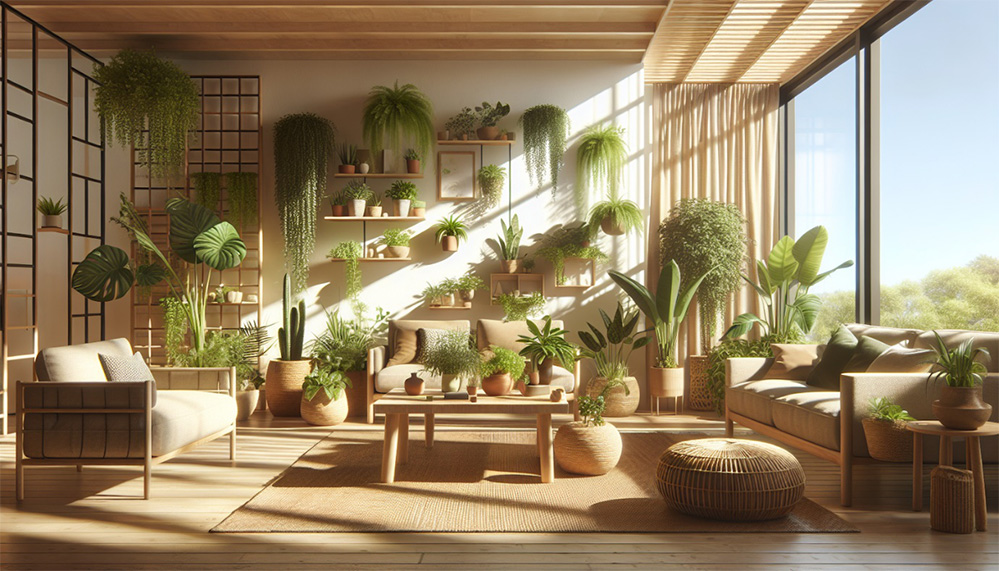
In the realm of interior design, biophilic design has emerged as a major trend, captivating attention by its ability to enrich environments with natural elements such as sunlight exposure, plant life and organic substances within your properties. This surge in popularity is attributed to an increased emphasis on creating spaces that not only look good, but also contribute positively to the inhabitants’ wellness and their bond with nature following the global health crisis.
Far from being merely decorative, incorporating aspects of biophilic design and sustainable design into living spaces comes with substantial benefits. It helps alleviate stress levels while enhancing air quality and general contentment among residents. In response to these advantages, more landlords and designers are embracing this concept for HMOs acknowledging how vital it is in crafting functional yet soothing interiors that maintain a thread to the natural world outside. Our discussion will delve into transforming your living areas using plants combined with naturally-sourced materials—a powerful combination promising inviting living quarters imbued with well-being enhancement features.
Natural Materials
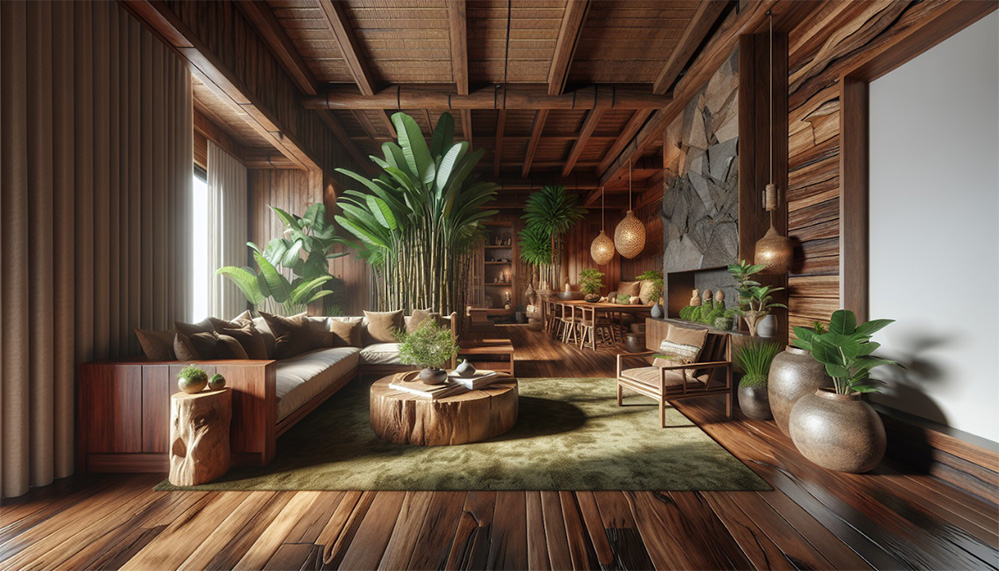
Incorporating wood, stone, and bamboo into interior design brings organic authenticity to your living spaces. These natural materials not only amplify the room’s aesthetic appeal but also promote a healthier ambiance within it. Wooden elements, such as reclaimed wood, alongside stone features can foster warmth in a space, creating an inviting atmosphere that resonates with nature’s tranquillity. Implementing these interior design concepts can revolutionise the feel of your living areas.
Strategically including such components in furniture and decor has the potent ability to enhance any space’s overall mood, rendering it more aesthetically pleasing and comfortable for its inhabitants.
Adding Plants
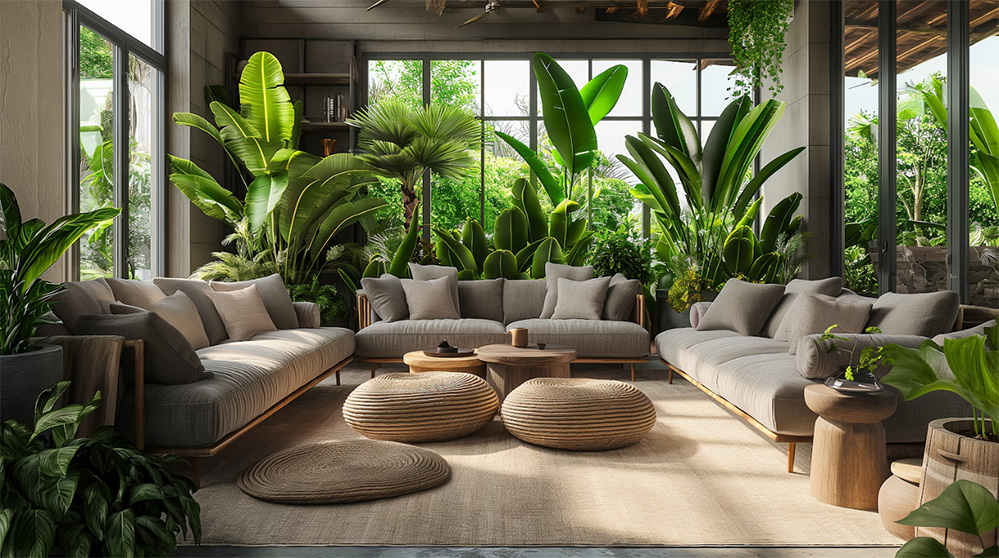
Incorporating indoor greenery into the interiors of HMOs can significantly enhance air quality and contribute to creating inviting living areas. The innate qualities of plants allow them to:
- Purify the air by filtering out toxins, which promotes a healthier habitat for tenants
- Introduce elements of nature inside, thus improving the aesthetic appeal
- Create a more hospitable environment in residential spaces
Adding potted flora in communal zones or setting up vertical gardens within kitchen spaces are just some ways that greenery can be integrated into your layout. Such additions are instrumental in generating an atmosphere that is both appealing and welcoming.
Colour Schemes for Modern Living
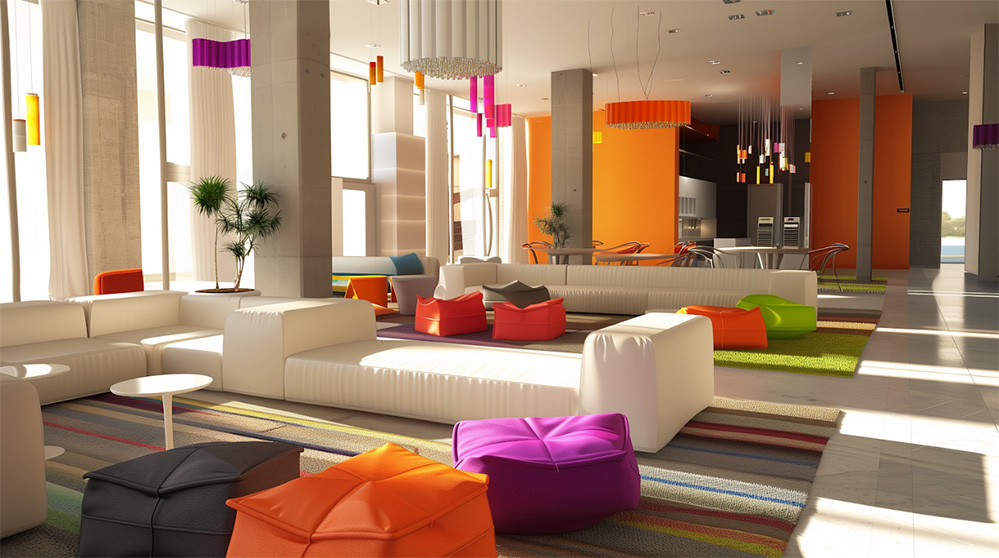
In the realm of HMO property interior design, selecting an effective colour scheme is crucial for transforming living areas. Modern living calls for a fusion of light colours, vibrant hues, neutral tones, and current shades in line with interior design trends anticipated for 2024 to foster welcoming and aesthetically pleasing environments. Colour wields significant influence over emotions and perceptions, which underscores its importance within the sphere of interior design.
The fashion-forward colour palette encompasses an eclectic mix that includes:
- Serene neutrals
- Earth tones exuding warmth
- Subdued versions of red
- Deep jewel-toned accents
- An array of grays
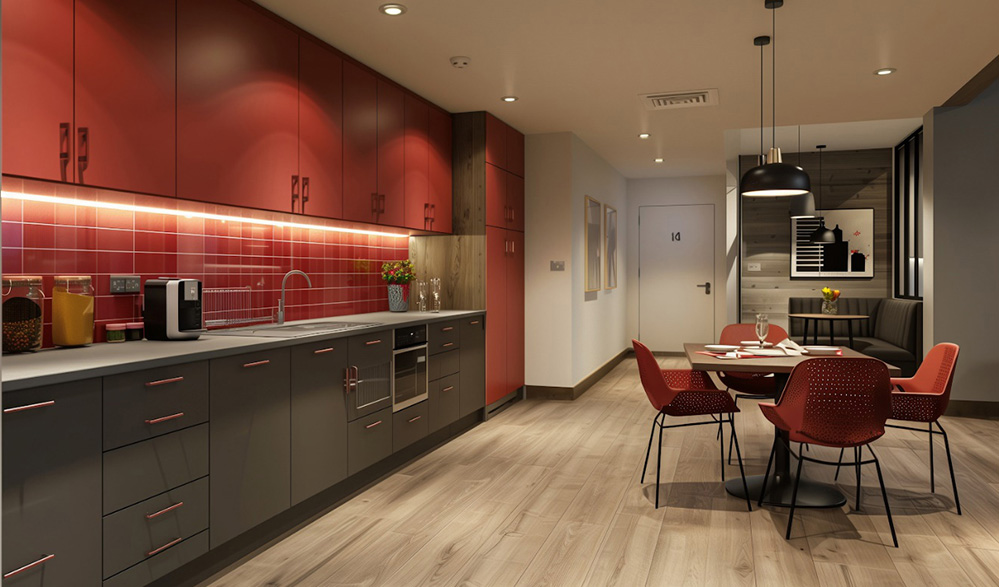
These chosen hues are crafted to evoke comfort and warmth thus enticing tenants by making them feel more at home which may result in longer tenancies. Our discussion will Explore how strategic applications of dynamic bold colours alongside subdued lights can transform contemporary residential spaces into places people long to live in.
Bold Colours
Rich blues and deep greens, when used as bold colours, have the potential to become eye-catching focal points within communal areas. They accentuate particular features or spaces effectively. Incorporating bold colours through accent walls can also be an excellent way to add vibrancy. These vivid tones can contribute positively to a space’s atmosphere while maintaining balance with neutral shades, thus avoiding over-saturation.
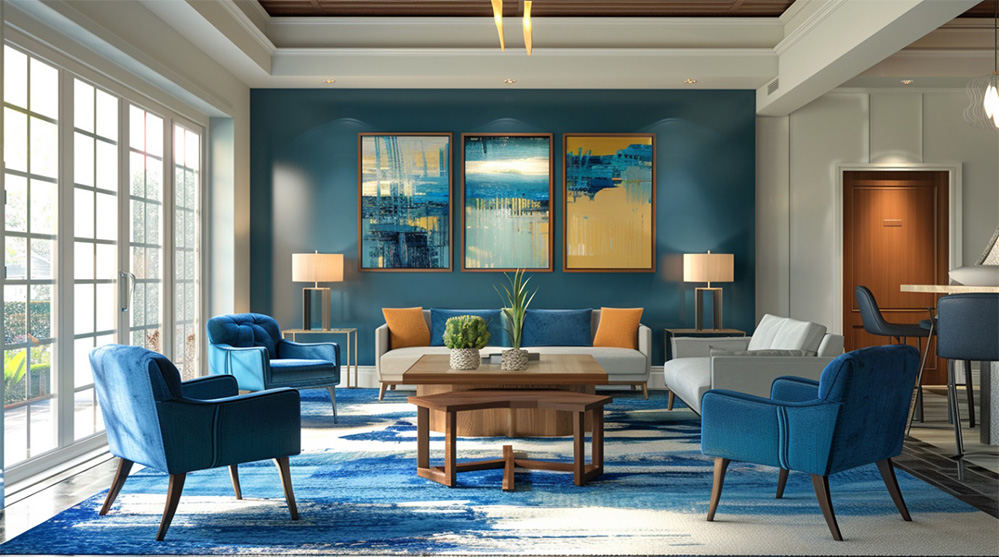
By weaving vibrant colour palettes and distinctive accents into communal spaces, one can infuse personality and cultivate inviting atmospheres where people feel at ease to unwind.
Light Colours
Utilising light shades such as pastels and off-whites is ideal for creating an illusion of a more expansive and welcoming area, especially in small rooms. For instance, soft pastels can be used as an example of light colours that enhance the space. These hues have the ability to reflect natural light, amplifying the perception of space while fostering a brighter and more open atmosphere. In HMO design, incorporating these colours contributes not just to the semblance of increased space but also to making the rooms feel congenial and agreeable.
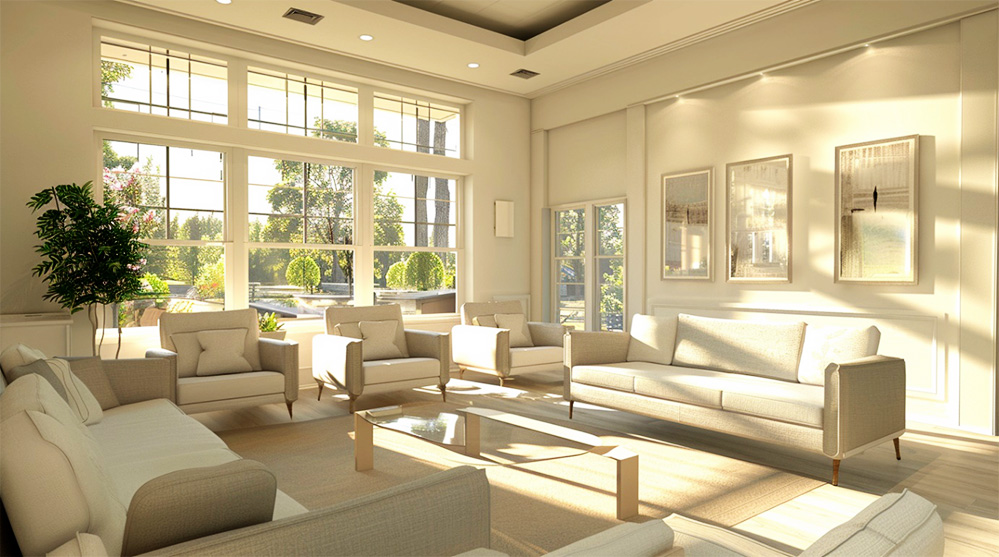
Top Tones
In 2024, the rental market is being influenced by popular colours such as earthy hues, warm neutrals, rich deep greens, and cheery shades of lilacs and yellows. The Dulux Colour of the Year for 2024 is Sweet EmbraceTM – a soothing blossom pink that imparts warmth and tranquillity to any space.
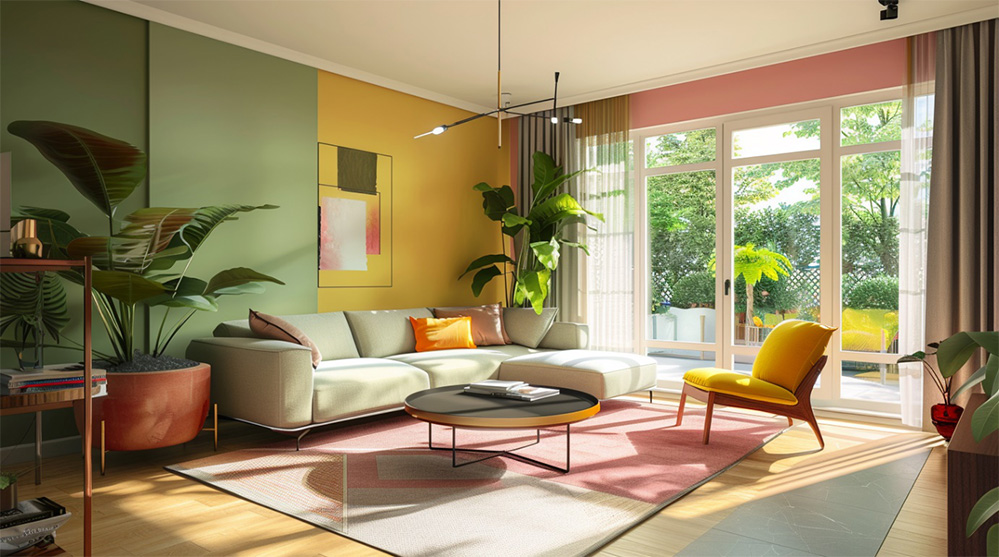
These colour choices are shaping spaces within the rental sector, crafting settings that not only follow current trends but also offer tenants comfort.
Smart Furnishing Solutions & Interior Design Ideas
Astutely selecting furniture for your properties is essential to creating habitable spaces that are both functional and visually pleasing. Incorporating space-saving furniture can greatly improve how tenants experience their environment, merging practicality with aesthetic charm. Achieving this fusion is key to not only drawing in occupants but also keeping them content, as well-crafted HMOs have the potential to yield higher rentals and assure tenant satisfaction.
In crafting an effective HMO design, it’s important to consider pieces of furniture that optimise space use while still looking stylish. There exists a variety of innovative methods ranging from multipurpose furnishings to cost-effective options and custom-made items suitable for outfitting an HMO catering to modern lifestyle requirements. These clever solutions for furnishing will be explored more thoroughly.
Multi-functional Furniture and Interior Design Trends
Multi-functional furniture is a game-changer in HMO design, offering essential functions like storage, seating, and sleeping within a single piece. Some examples of multi-functional furniture include:
- Custom-made ottoman beds that provide extra storage solutions while catering to specific tenant needs
- Sectional sofas that can be rearranged to create different seating arrangements
- Nesting side tables that can be easily moved and used as needed
- Convertible furniture, such as sofa beds, that can transform to serve multiple purposes
Selecting multi-purpose and modular furniture allows tenants to reconfigure communal spaces according to their needs, making the most of the available space.
Designing with multi-functional furniture supports the creation of well-functioning spaces that offer both comfort and utility. Expert advice is often available to help choose the right multi-functional furniture for maximising space efficiency, ensuring that every piece serves a purpose while enhancing the overall aesthetic.
Budget-Friendly Options
Affordable furnishings that are both cost-effective and chic can attract tenants who desire a balance of affordability and quality. Even at discount prices, stores such as IKEA offer an array of furniture pieces that are trendy yet economical.
Students renting spaces especially value this combination, as they typically look for living arrangements that are budget-friendly but also functional and visually appealing. Affordable solutions from various outlets ensure students don’t have to sacrifice style for price when it comes to their accommodations.
Bespoke Furniture
Custom-made furniture provides distinctive and personalised options for spaces within an HMO property, meeting the unique requirements and tastes of individuals. These custom designs offer the flexibility to test various configurations and styles within a single property, made possible by these tailored furnishings.
Such customisation can greatly increase the attractiveness of a property in the highly competitive rental market, helping an HMO stand out with its bespoke layouts and designs.
Effective Use of Lighting
Crafting vibrant and flexible living spaces in HMO properties is crucial, with effective lighting playing a pivotal role. By merging sources of natural, ambient lighting, and artificial light, the feel and utility of a space can be significantly improved. Recognising the flow of natural light into a room helps strategically place artificial lights for an evenly illuminated setting.
Incorporating layered lighting that involves ambient, task, and accent fixtures transforms any area into a dynamic living space. The use of dimmable light options offers versatility to modify atmospheres according to different times or functions within the day. We will delve deeper into how best to harness both forms of illumination—natural and manufactured—to their fullest potential.
Natural Light to Lift Dark Colours and Create the Opulence of Enough Space
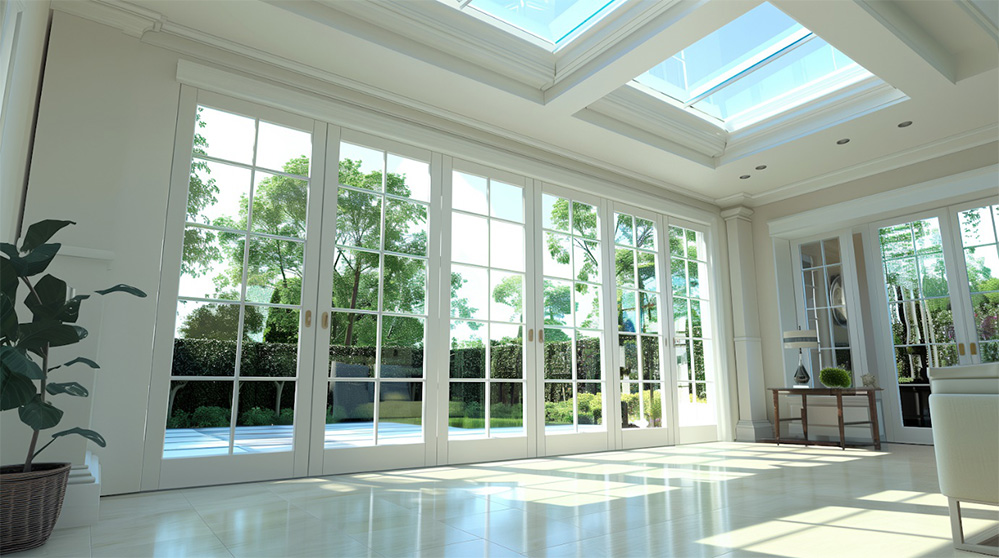
Incorporating design elements such as skylights, expansive windows, and glass doors is a strategy to maximise the entry of natural light into a room. By implementing larger windows or installing skylights, one can notably boost the ingress of daylight exposure in spaces, creating an ambiance that feels both more spacious and welcoming.
Utilising reflective materials like mirrors serves to bolster the presence of natural light within a space. These surfaces effectively capture and scatter light throughout the area, thus elevating its overall luminosity and contributing to a perception of increased openness.
Artificial Light
Three categories of artificial lighting play distinct roles in forming a brightly illuminated area:
- Ambient lighting: delivers overall light to a space.
- Task lighting: concentrates light on particular zones for tasks such as reading or working.
- Accent lighting: emphasises elements like architectural details or art pieces, generating an attractive centre of interest.
Options like energy-efficient LEDs and intelligent bulbs provide the ability to tailor lighting atmospheres while also improving both convenience and the conservation of energy.
Creating Functional Communal Spaces
Functional spaces are essential for fostering social interaction and relaxation in HMOs. When these communal areas are thoughtfully designed with shared amenities, they not only help residents build relationships, but also contribute to a tightly-knit community atmosphere, improving the quality of life within the residence. These spaces ought to be welcoming and conducive to nurturing a feeling of belonging and camaraderie.
In our analysis, we will delve into how strategic layout planning, cosy seating options, and appealing decorative elements play pivotal roles in shaping functional yet attractive communal spaces that encourage connection among residents.
Layout Planning
Strategic planning of the layout, including an open-plan design, avoids congestion in communal spaces, facilitating ease of movement and access. By establishing distinct zones within these communal areas, a balance is achieved between social engagement and individual tranquillity, thus creating spaces that accommodate the requirements of all tenants effectively, ensuring each area operates efficiently as a well-functioning space.
Comfortable Seating
To foster a sense of comfort and promote prolonged use of communal areas, it’s important to equip these spaces with sturdy and cosy seating arrangements. Ergonomic chairs, for instance, provide excellent support and comfort, making them a great addition to any communal space. By incorporating an assortment of seats like couches, lounge chairs, and beanbags, both the practicality and visual appeal of communal environments can be greatly improved. This approach not only makes the space more appealing but also caters to a range of activities including social interaction or simply unwinding.
Decorative Elements
Incorporating artistic decor and plush rugs into shared spaces can transform these areas into cosy, personalised environments. It’s crucial that these decorative items align with the HMO’s overarching aesthetic and colour palette to ensure visual harmony.
By infusing communal zones with such inviting touches, landlords can foster a homely ambiance that makes tenants feel truly settled in. This approach not only enhances the comfort of residents, but also helps to establish properties that exude warmth and hospitality.
Energy-Efficient Appliances
The integration of energy-efficient appliances in HMO properties plays a pivotal role in reducing utility costs and shrinking the carbon footprint. These appliances, such as smart thermostats, can significantly reduce energy consumption and operational costs, making the property more attractive to environmentally conscious tenants. Using energy-efficient appliances can enhance a property’s environmental sustainability, contributing to a lower carbon footprint and higher EPC rating.
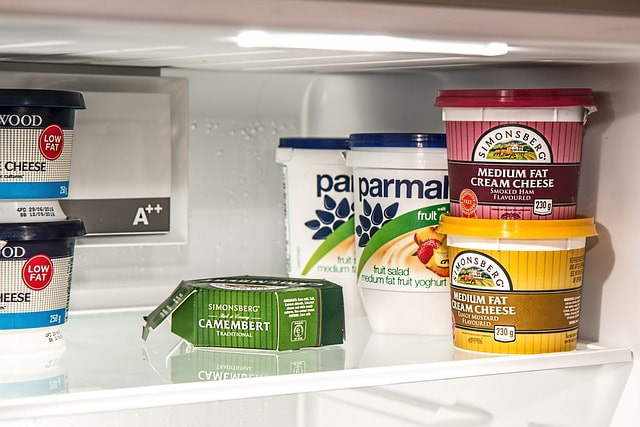
The benefits of energy-efficient appliances extend beyond cost savings. They also offer advanced features that enhance convenience and performance, making everyday tasks easier for tenants. We’ll delve into the advantages of energy efficiency along with some optimal appliance choices suitable for HMOs.
Benefits of Energy Efficiency
Installing energy-efficient appliances can lead to significant cost savings by lowering utility bills. These savings are particularly important in HMOs, where multiple tenants share the same utilities. Lower energy bills can be a strong selling point for prospective tenants, making the property more attractive. Additionally, A+++ appliances help reduce greenhouse gas emissions, contributing to a lower carbon footprint and a more sustainable living environment through the use of green technology.
Improving a property’s energy efficiency can have several benefits, including:
- Increasing its EPC (Energy Performance Certificate) rating, which can make it more marketable and potentially increase rental income
- Attracting environmentally conscious tenants who are more likely to choose properties with higher EPC ratings
- Promising lower energy costs for tenants, enhancing their satisfaction and retention
Energy efficiency is a win-win for landlords and tenants alike.
Top Appliance Choices
When you’re in the market for these types of appliances, look for those that combine cutting-edge features with exceptional performance. Prioritise energy-saving devices to optimise your choices for HMOs. Here are some examples:
- Sporting an A rating, the Bosch Series 6 KGN39AIAT Fridge Freezer only uses a minimal 0.5 kWh per day, making it a superb option to lower electricity expenses in any kitchen.
- The ASKO T608HX.S Heat Pump Dryer comes with an impressive A+++ efficiency grade.
- Boasting an A+ energy certification is the Miele H 2861 BP oven.
All these devices stand out for their top-notch efficiency.
These particular models not only help decrease energy consumption, but also incorporate modern convenience and advanced capabilities designed to simplify life for your tenants.
Create Properties toTailoring Design to Target Tenants
Tailoring the design of HMO properties to appeal specifically to intended tenant groups is crucial for attracting and keeping a diverse array of tenants. Recognising tenant preferences, such as what different types of renters, including young professionals, families, and students, want in their living spaces, can significantly boost your property’s attractiveness. Landlords who synchronise interior design with the desired experiences and ambiance sought by ideal tenants are more likely to establish functional living spaces that cater precisely to these needs.
Engaging an interior designer can be instrumental in enhancing both the practicality and visual appeal of communal areas within a property. By ensuring that the design process is finely tuned to reflect the profile of prospective occupants, landlords adopt a calculated approach towards crafting spaces which not only draw but also retain desirable tenants. This intentional focus on meeting specific lifestyle requirements elevates both value and appeal for HMOs aimed at demographics such as professionals, families or students.
Young Professionals
New professionals are drawn to HMOs that boast modern amenities.
- Contemporary, chic aesthetics
- Kitchens furnished with modern appliances
- Amenities compatible with technology
- Rapid internet connectivity
- Devices enabled for smart homes
- Facilities such as fitness centres and shared workspaces
Inclusion of these elements can elevate the appeal of an HMO for this group and contribute to their well-being.
Tailoring designs to accommodate these tastes can entice professionals in search of living spaces that align with the demands of contemporary life while fostering their dynamic way of life.
Families
Families are in search of living spaces that offer generous communal areas, amenities suitable for children, and a close distance to educational institutions. Designs of family-oriented HMOs frequently incorporate family-friendly features such as:
- play areas with security features
- substantial storage solutions
- adaptable space configurations within the home
- expansive indoor living quarters
- exterior areas designated for kids’ activities
- strategies to lessen noise pollution
- provisions to enhance personal privacy
Incorporating these aspects guarantees a cosy atmosphere conducive to family life.
Landlords who cater to these preferences can craft welcoming environments that attract families seeking a secure and nurturing neighbourhood community.
Students
Affordable accommodation, study-friendly environments, and communal spaces for socialising are at the top of students’ list of priorities. When it comes to crafting spaces for student tenants, incorporating study zones that offer ample desk space and proper lighting is key. Utilising cost-effective yet practical furniture like fold-out desks that also serve as dining areas helps optimise space within compact living quarters.
Integrating communal areas where students can gather plays a vital role in fostering community bonds and promoting a well-rounded student lifestyle.
Summary
In recapitulation, the forefront of HMO design in 2024 prioritises crafting spaces that are both appealing and functional while fostering tenant well-being. The incorporation of biophilic elements through the use of natural materials and introduction of foliage significantly improves occupant health and satisfaction. Selecting an optimal palette with everything from vibrant to soft tones can revitalise living quarters into warm, welcoming settings. It is highly recommended to hire an interior designer so they can help you to visualise the final results.
Ingenuity in furnishing choices is critical. Multi-purpose furniture pieces and custom fixtures provide a balance between utility and fashion. Strategic lighting plans merge daylight with man-made illumination for lively interiors. Integrating energy-saving appliances lowers operating costs while supporting eco-friendly residence practices. Customising your HMO interior specifically for its intended demographic—be it wealthy professionals or students—amplifies property appeal and enhances tenancy rates. By implementing innovative interior design ideas and innovative solutions, landlords can create appealing and functional spaces that attract and retain tenants. Landlords informed about these tendencies can successfully establish sophisticated yet practical homes suited to contemporary lifestyles.
Frequently Asked Questions
What is biophilic design, and why is it important for HMOs?
Incorporating natural elements into HMOs through biophilic design can lead to a reduction in stress, betterment of air quality, and an increase in productivity, all while enhancing well-being and fostering a deeper connection with nature.
How can I use bold colours without overwhelming the space?
Incorporate bold colours into your space in a way that doesn’t overpower it by harmonising them with neutrals. This approach helps to establish areas of visual interest while ensuring the surroundings don’t appear excessively cluttered.
What are some budget-friendly furniture options for HMOs?
Exploring outlets and discount stores such as IKEA could be particularly advantageous for sourcing stylish yet affordable furniture suitable for Houses in Multiple Occupation (HMOs).
Such establishments offer an excellent selection of budget-conscious, contemporary furnishings that will appeal to student tenants seeking economical but attractive options.
Why are energy-efficient appliances beneficial for HMOs?
Utilising appliances that are energy efficient is advantageous for Houses in Multiple Occupation (HMOs) as it cuts down on the amount of energy used, diminishes running costs, promotes environmental sustainability, and has the potential to elevate the property’s Energy Performance Certificate (EPC) rating. Such measures lead to gains both economically and ecologically.
How can I tailor my HMO design to attract young professionals?
To appeal to professionals, concentrate on incorporating contemporary and polished aesthetics along with kitchens that are fully furnished. Ensure the inclusion of amenities tailored for tech-savvy individuals such as high-speed internet and smart home technology, as well as facilities like fitness centres.
These enhancements will significantly increase the attractiveness of your HMO to a younger professional audience.
If you like our ideas, get a free no obligation quote today.
07399651836